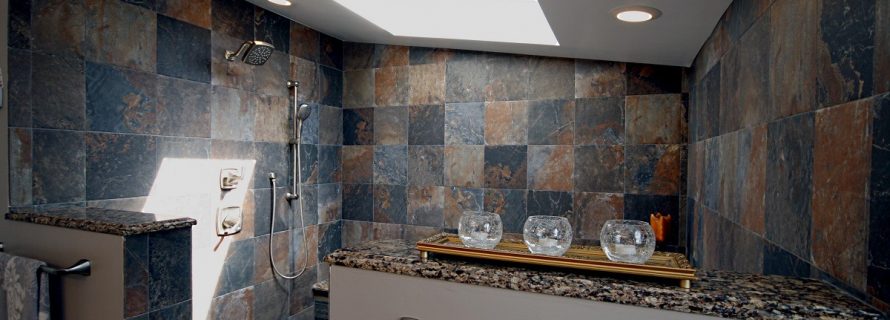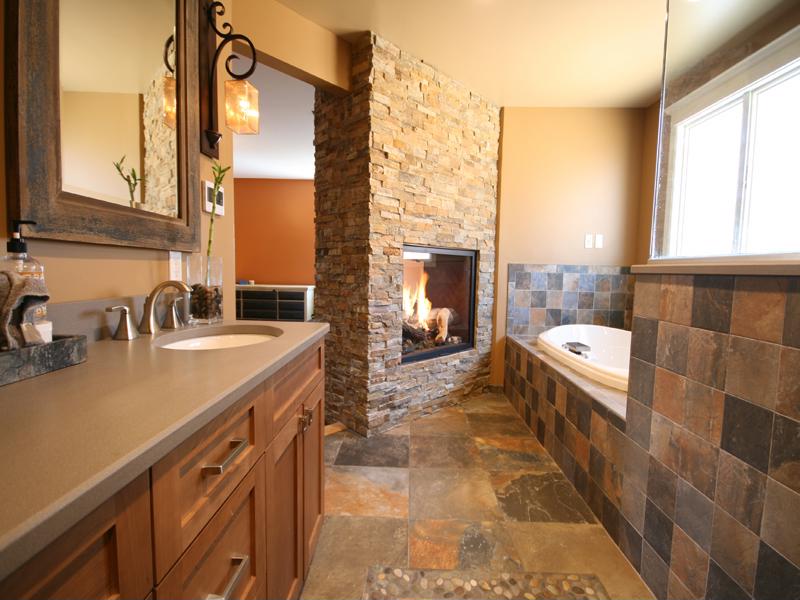Open floor plans: Not just for the kitchen

When you eliminate the barriers of walls within certain areas of your home, you can instantly make a space feel bigger – which is one of the reasons why open floor plans have become such a popular design trend.
Open floor plans are often used in the kitchen, with homeowners opting to forgo the wall between the kitchen and living or dining room in favor of an area that is more spacious, accessible and flexible. But this interior design strategy isn’t just useful for kitchens. No matter where in the home it is applied, open space plans offer many benefits.
Bathrooms without barriers
In addition to making the rooms look bigger, they can also all allow for a more fluid, consistent and cohesive aesthetic, as well as a convenient layout to maximize the use of space. This is especially beneficial in rooms that typically tend to feel small and cramped, such as bathrooms.
“Because so much time is spent there, more homeowners are requesting bigger bathrooms,” explained Alure Designer Roe Mikelinich.
“Open floor designs can make a small bathroom feel more spacious.”
There are many ways to make a bathroom feel bigger and more spacious. On the more extreme end of the spectrum, you have the option of completely combining the master bedroom with the bathroom, making it reminiscent of some luxury hotels’ master suites. These layouts can be chic and somewhat edgy, providing homeowners the ability to enjoy some of the features of their bedroom, such as their TV or a fireplace, while they take a bath or get ready for bed. On the other hand, it also eliminates privacy – which is why they are certainly not for everyone.
But you don’t need to completely merge your bathroom and bedroom together to enjoy the benefits of an open space design. If you want to make the room itself bigger, one option is to “build it out” by knocking down a wall between the bathroom and an adjacent area, such as a closet that you don’t often use. However, there are also ways to create a more open and spacious bathroom by working only with the room as it is now and replacing, updating and remodeling what you already have.
Create a wet room
One of the easiest yet most effective ways to implement an open space design in the bathroom is to transform it into what is referred to as a “wet room.”
Mikelinich explained that wet rooms are often made up of a continuous floor, two drains and a shower rain head that hangs down from the ceiling. There is no shower door – everything is encased behind custom glass. Because shower and bath tubs are often the fixtures that take up the most space in a bathroom, focusing on breaking down the barriers around them makes sense. When designing a wet room, there are specific factors to consider.
“For the shower floors, smaller mosaic tiles are recommended because the pitch of the drain needs to be a certain way so the water doesn’t pool,” Mikelinich said. “The biggest tile will usually be a three by three. As far as the walls in the shower, you can use whatever kind of tiles you want. Larger subway tiles are gaining popularity, but there is a wide range of options to choose from.”
A wet room makes for a wonderful, spacious open bathroom design because you can still have an organized and segregated space without making it seem smaller or cramped. Furthermore, the continuity of tiling along the shower walls and floors unifies the design, blurring visual barriers and making the area feel like one big room. At the end of the shower area, for example, the small mosaic tiles will be capped off when it transitions to another part of the bathroom – such as the vanity area, with a flat slab of marble or quartz. And though it separates the two sections of the bathroom, there is nothing to step over.
The thing with these bathrooms is that you need the space for it. If you are working with a relatively small area that you don’t think will be suited for a wet room transformation, consider some of the following ideas.

Tips for big bathroom designs
Even minor changes can have a dramatic effect on the room and go a long way in making your bathroom feel more spacious.
- Use small fixtures. Smaller fixtures can make the area immediately feel more expansive. By installing pedestal and wall-mounted sinks, shallow vanities and other thin, flat structures that are close to the wall, you can maximize floor space and create more room for storage.
- Minimize dividers. You can even create more space by having the door swing outward into the next room, rather than inside the bathroom. You may also want to consider removing the door altogether. If you want to maintain a degree of privacy within the bathroom, without making any one section feel too closed-off, you can also utilize a peek-a-boo shower, and use small dividers and glass enclosures. If the shower doors are frosted glass, for example, it gives you privacy but the transparent materials also make the doors look bigger than they are.
- Be especially mindful of textures, colors and materials. Reflective and monochromatic surfaces can help create the illusion that a room is bigger and more open. Consistency in colors, especially lighter tones, can also add to the expansiveness of the environment. The less visual barriers between certain areas and sections of the bathroom, the better.
- Consult with a design expert. At the end of the day, there are probably many ways you can maximize the space of your bathroom and remodel it in a way to make it feel significantly more spacious. However, unless you specialize in home design and remodeling, there’s no way to know whether you are taking advantage of the right solutions that will provide you with the greatest value. This is why you should consult with an experienced contractor.
Open space designs have the power to turn an otherwise cramped and crowded area of your home into one that feels large and luxurious. Because of the plumbing and electrical requirements involved in the bathroom, you want to be as careful and thorough in planning your redesign or remodeling project as possible. To learn more about how to properly plan and prepare for a bathroom renovation, download our whitepaper:
- Additions and New Construction
- All Exteriors
- Alterations
- Basements
- Bathrooms
- Customer Service
- Customer Stories
- Decks
- Design & Planning Show
- DIY
- Doors
- Educational Resources
- Extreme Makeover Home Edition
- Fashion Show
- General Remodeling
- Green Living
- Handyman Home Services
- Home Decor
- Home Entertainment
- Home Improvement
- Home Improvements
- How to Tips
- In The Community
- Kitchens
- Off-the-Wall Remodeling Stories
- Remodeling
- Resources
- Roofing
- Siding
- Social Media
- Sunrooms
- Tips & Tricks
- Trends
- Windows


